Rescuing a good product from bad customer service.
I’ve been setting up my house for wireless music throughout. The technology I chose is Apple’s Airplay. It has a terrific feature set, it operates over my existing wi-fi, and the components are inexpensive. Most rooms need only a second-hand or refurbished Aiport Express, and rooms with televisions get an AppleTV. The system allows me to enable any combination of zones, and stream all my media to anywhere, from my computer, tablet, or phone. Cheap, easy, and powerful. All it needs is amplifiers!
The Airport Express is a fantastic (and wildly underappreciated) little box for slinging wireless music around. The output is line-level however, so it needs an amp. I searched for a nice compact amplifier that could drive bookshelf speakers from the Express, and found Amphony’s Model M100. It’s a lovely looking little amp, has good reviews, and is reasonably priced. So I ordered one to try it out.
Things got weird right away. The company seems to be based in New York, but this amp was sent to me via USPS from a house in Illinois. The address seemed odd, so I googled it, and it’s just some woman’s house in suburbia (her name was in the originator address from USPS). Strange, but okay, I have my amp.
Well, it was Dead On Arrival.
The next step was to call Amphony customer support. The customer support phone number on their website doesn’t go to a company switchboard or anything- it rings directly to some guy named Abraham’s desk. Okay, maybe it’s a small company. I left a message for Abraham, but never got a response. Days, went by, and I kept trying. Then weeks went by. I tried email as well. Finally, Abraham did get back to me, I explained the situation, and he seemed genuinely interested in helping. He issued an RMA, took my address, and said a replacement was en route. More weeks went by. I started calling and emailing again. No response. By now, it’s been months, the replacement never showed up, and my calls and emails are being ignored. Abraham no longer seems to exist.
So, I’m out $70, right? Well, nothing to lose now, so I might as well crack it open and see if it’s an easy fix.
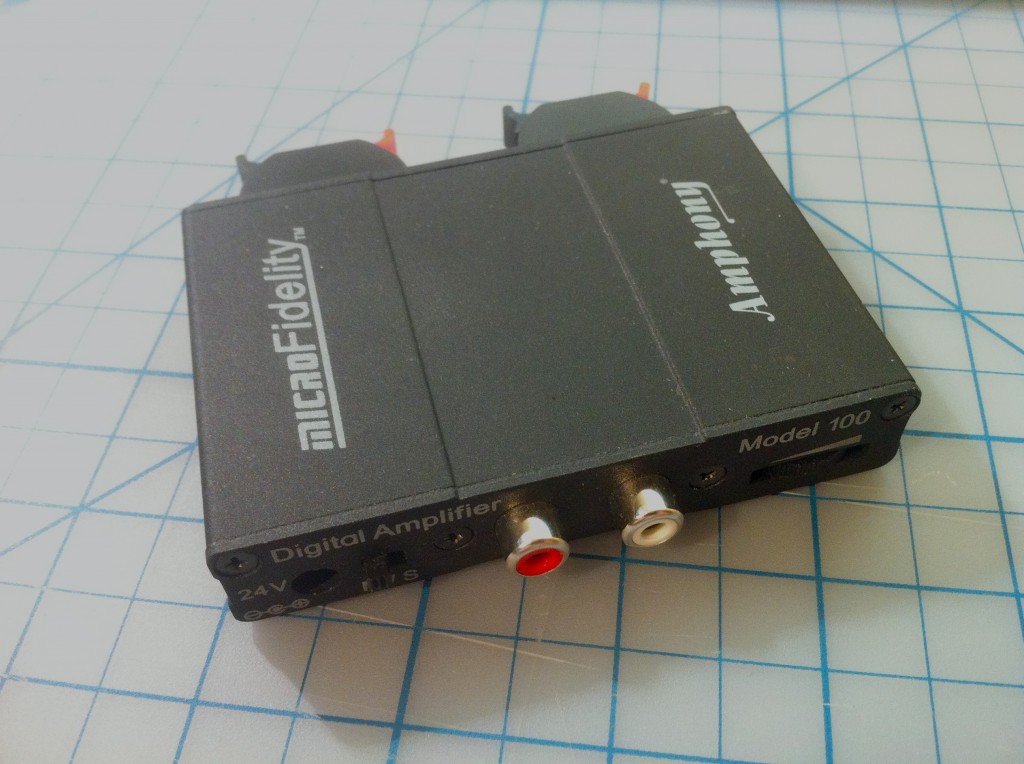
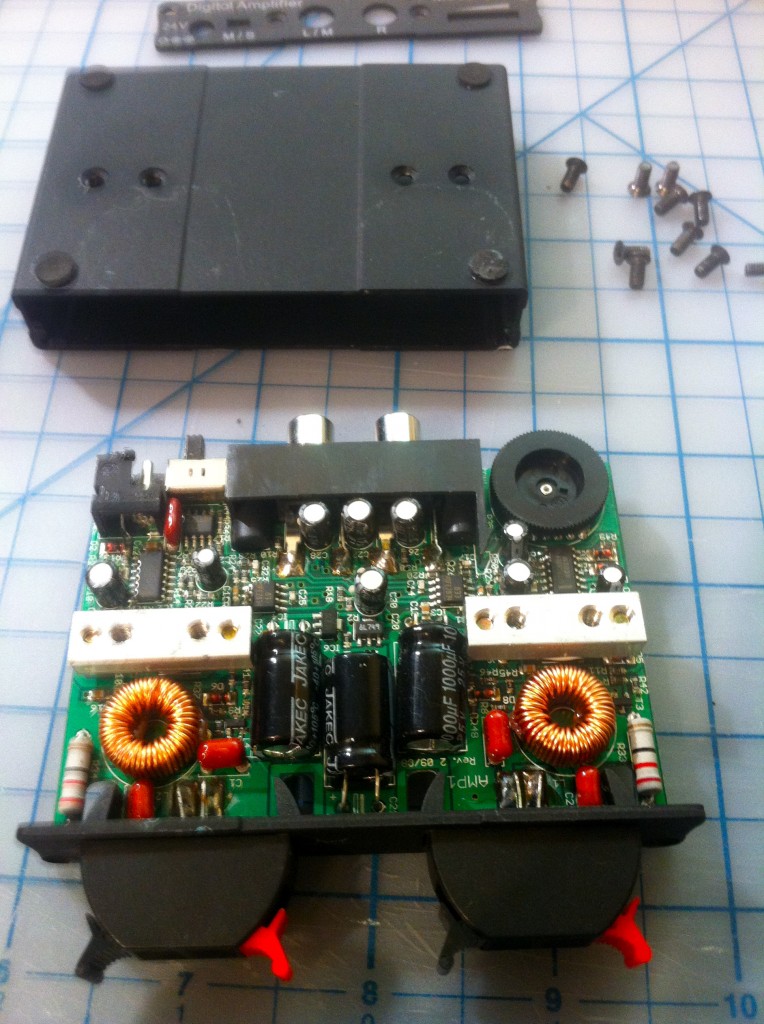


Now all I needed was three replacement caps. To the parts drawer! Sadly, I have plenty of caps in that size and voltage rating, but none that are exactly the same form factor. I tried in vain for a while to make some other cap fit, but space is really tight. So tight that the PCB has holes cut in it for clearance on these caps. No other ones would do- they need to be this exact size.
To the junk pile! I have all kinds of busted old gear here. Surely something has the right caps in it.
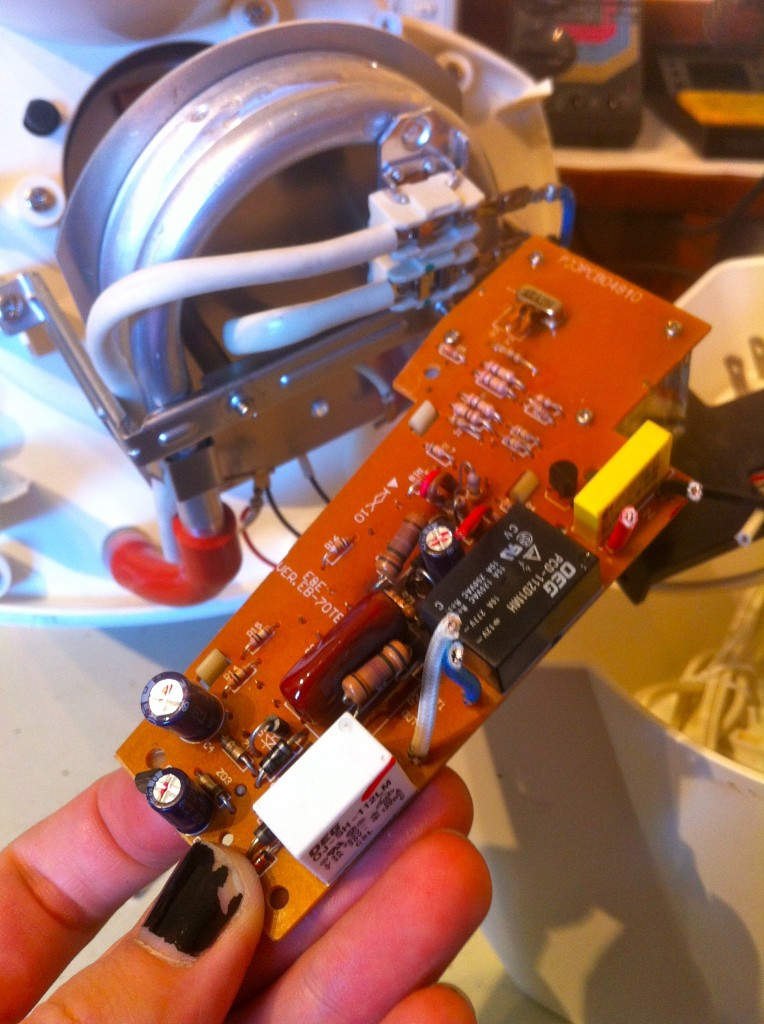

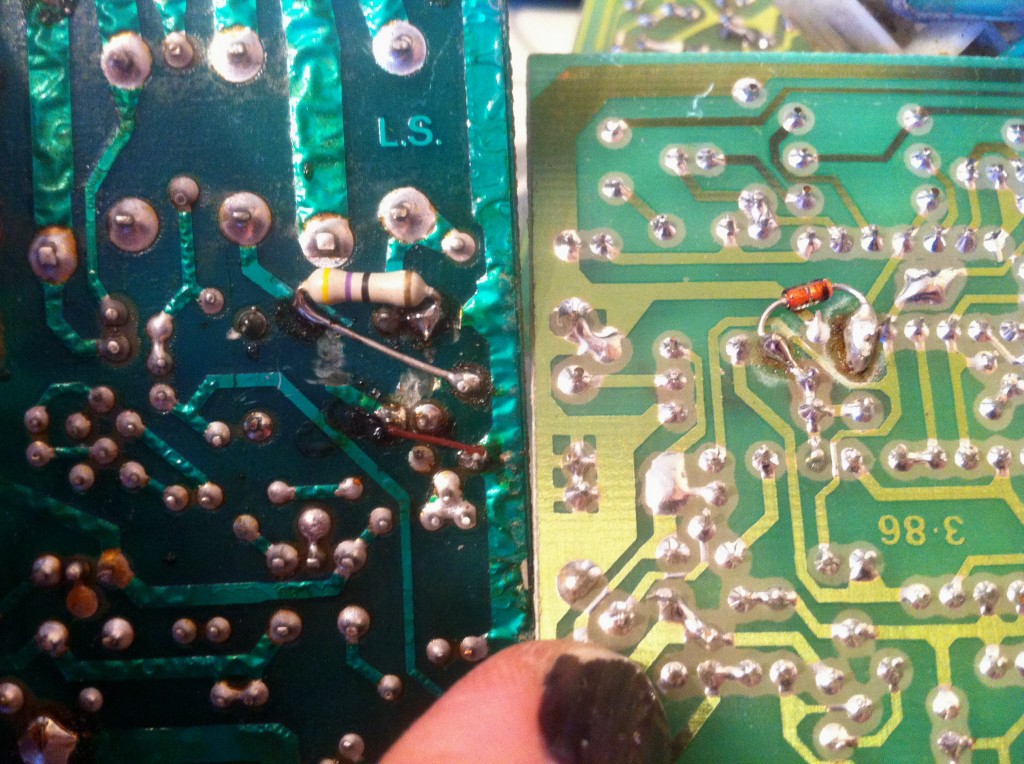
Well, all this electronic archeology is fun, but ripping old shit apart is not netting me the caps I need. In the interest of time, I went off to DigiKey and found the caps there. Thankfully, the online distributors are very detailed about their stock, so I could find the exact dimensions of cap that are required here.
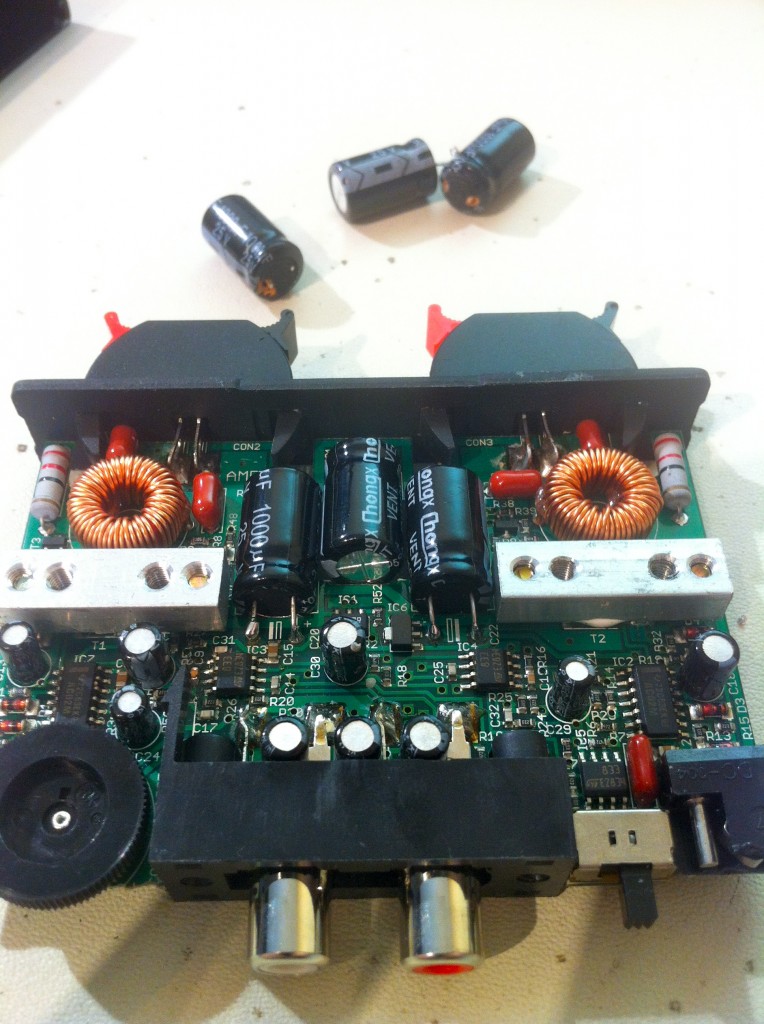
Now for the big test! Was that all that was wrong with this amp? Only one way to find out.
Result! A quick run through all the features, and it’s clear those caps were the only problem. 35 cents later, and my $70 investment is rescued. It really is a very nice amp. What is going on with Amphony’s customer service, anyway? Guys? Anyone there? Bueller?
Hey,
Found your site recently and have avidly read through your Veronica build.. Very interested in doing something similar.
Anyway on the subject of amplifiers, have you thought about making some amps, the gainclone is an interesting little beastie and can be quite cheap if you have lots of bits in your spare parts bin..
Lots of info on the internet about these and I have quite a bit also if you are interested..
Loving your hacks.
Take care.
David.. BD
I second the gain clone idea. Some time ago I found a pair of Yamaha speakers at Costco that seemed just the right size to use for my office as high qualilty computer speakers. I hung them on the wall with some speaker hanger hw from rat shack. They have 5″ woofers and 3/4″ tweeters. Speakers this size typically have an F3 of about 100hz so they won’t give a hugh low end (I have a sub woofer in the works!). Anyway you can’t drive these with the sound output of your PC so an amplifier is needed.
My first attempt at an amp used 2n3055s and MJ2955’s driven by a 2n3904/2n3906 pair. It was your classical comp/sym. amp with a ‘741 op amp front end. I used a 25vct power transformer so I expect the amp was good for about 10W output. Then I “discovered” the LM3866. This IC is the equal of all the discrete junk I had pooled together to build my first amp. The classic ‘gain clone’ is based on over rated (and over priced) ‘Gain-Card’ amp that audiophools have been drooling over. I found two small but study heat sinks (one per chip/channel) and some sheet aluminum and built a nice cabinet with the heat sinks on either side with the aluminum sheet forming the top/bottom/front/back of the box. I took two disgarded chassis boxes and stacked them to make a second box for my power supply. I’m running the gain-clone at +/- 28 volts (using two 12volt and one 18vct transformer in series), which should give me about 25 watts into 8 ohms. Google for LM3886 or gainclone for more ideas.
Yah, I have thought about building my own amps. I’m still thinking about it, but also need to pick my battles a bit. There are some cheap Chinese class-D amps for $15 on amazon. I picked up one of those and I’m going to see how it works. It’s built like crap, as you would expect at that price point. However, my needs for this are modest- just need some tunes in the garage and a couple of other corners of the house.
Ok point taken, and I wouldn’t want to be the cause of limiting your time with Veronica, but if you get the urge in the future for a bit of Amp magic then consider, other than the power supply you only need an LM3886 ( a whole $4.20 AUS from futurlec.com.au ) and about 7 passive components and you have a working amp.. I was very impressed with these and made a couple that run on a 12v line from a PC powersupply.. Won’t win any awards but impressive for what it is..
Take care.
David.. BD
If you’re still looking for another amp I bought this amp: http://www.amazon.com/gp/product/B001P2R1RW/ref=oh_details_o02_s00_i00
last year and could definitely recommend it. I wasn’t sure what I would be getting for only 55 bucks but it turned out really nice. I have it attached to 2 bookshelf speakers and can’t even put the volume halfway up without it being too loud for my small apartment – and it still sounds good at these volumes!
Nice repair job but I wonder why the caps were hooped in the first place. It seems a lot of electronics are engineered to fail because a 3 cent part saves 2 cents per unit over a 5 cent part. ….Or it could be inadequate cooling and they just got too hot and burst?? I used to have a car audio amp that would get so hot that the solder on the resistors at the output transistors would go liquid and the resistors would drop out of the board which was mounted upside down. I solder-sucked the solder off and used a higher temp solder to fix it. It was super high current and you could probably arc weld with the outputs (kidding).
Hey, when you decide to build your own amp, try something vintage with tubes… I was all about Class D and solid state amps until I got a set of class a/b tube amps. The sound is amazing but to be honest they do need a little tweaking from time to time to keep voltages in check.
Keep up the great tinkering and writing : )
Since the amp was brand new, I can only assume the caps failed because they were old parts when they were installed. Or perhaps the amp itself was sitting on a shelf in some warehouse for years.
Yes, that’s still a bit odd though because typically when parts like that go, they release a puff of magic smoke when they go and although caps do have a shelf life they look way too new to have dried out. I was assuming that it wasn’t entirely new because the originating address was in the middle of nowhere. My theory is that that amp was supposed to get back to the company for repair and instead it was sent to you. Well, it’s a theory anyway : )
Another option was that the caps were bad when manufactured. I’m typing this on an iMac G5 that I had to replace all the caps on (yeah, remember the wave of ‘bad motherboard caps’, even Apple got burned).
Good write-up though, and good eyes: “You can see a lot by just looking” – Yogi Bera
So you went through the trouble or replacing crap caps with more crap caps, I’m all for recycling but I’d go out of my way to get some Rubycon, Panasonic or Nichicons that fit the bill…
Well, considering it took about 10 minutes and cost about 35 cents, I can handle redoing it in a few years if they fail again.
May well be sooner than a few years. The replacements you used are more cheap Chinese junk, I would definitely recommend a decent Japanese brand as MD already suggested.
I like to go by the motto “Do it once, do it right, never do it again”
Problem is that the Japanese brands are probably being made in Chinese factories these days! Actually I wouldn’t worry about parts I buy from top drawer distributors such as Digikey or Mouser. I would be cautious about parts purchased on Ebay though.
Nichicon HM and HN, see DELL computers from around 2003, Nichicon admitted those were contaminated.
Yeah I know, I was not meaning to be snide in my comment Blondihacks.
I’ve just found it easier to use good stuff, oh and BTW for below.. you can usually get “Engineering Samples” from most good distributors, Arrow, DigiKey etc.. even more so if you’re in the electronics manufacturing industry or a student. I was able to score a couple bags of Panasonic FM (very good) capacitors from motherboard manufacturers that sold motherboards with bad caps. Not sure if you’re familiar with them, but check out Badcaps.net
I just looked at one of these on my junk pile the other day and filed it for later. Later is now, thanks to this write up and Hack a day.
Nice hack. I find that a lot of things just needs new caps to work. Especially stuff from the 90’ties and the cap-plague.
The wierd repairs on the old car-alarm is probably just an after-fix from the factory. You don’t see it much these days, prolly since pcb-designsoftware has gotten better. Someone prolly found an error on the board afterwards and the company decided the fix was cheaper than making new boards.
Neat I’m working on a class D design at the moment based off the work of this paper:
‘An FPGA-Based Digital Class-D Amplifier Using Short Word-Length’ among others. Basic idea is to implement everything apart from gate drive and feedback ADCs inside an FPGA (sample rate conversion, modulation, feedback, general DSP). As for power supply I am thinking of a full bridge quasi resonant converter for super high efficiency. The power density of this unit is quite good but I think much more is possible. I think about 300W total continuous power output from a unit the size of a computer CDROM including mains input power supply is possible without resorting to anything very fancy in terms of copper base planes on PCBs etc. Its going to take me a while due to the extreme complexity of every part of the overall plan 🙂
Nice writeup and it stands on it’s own merit.
There’s a set of choices in part specs that often raise eyebrows no matter what we do. We can spec something to cost be damned levels or “Never Fail To Fail” cheapness.
Sometimes as you did- choosing “good enough” is just that,
It is even likely that the caps failed due to the way they appear to be bent over.
It doesn’t don’t look like the leads were pre-bent with pliers to allow them to lie sideways on the PCB. They were probably soldered in raised up and pushed over flat on the PCB with a thumb, which could have easily caused a weakened contact between the leads and the capacitor plates.
Oozing capacitors usually indicate excessive temperatures. It’s likely that the amp was exposed to an abnormally high temperature during the transit process, assuming it wasn’t originally assembled with defective caps. You’re fortunate that one of them didn’t decide to cough its cookies at power application and take out some parts along with it. Been there, done that, and cleaning up the mess isn’t much fun.
By the way, this story points out the foibles of buying sight unseen off the Internet. Call me suspicious or paranoid, but I’m real hesitant to exchange money for a product of unknown qualities produced by an unknown entity. It’s caveat emptor all over again.
Now, back to Veronica!
Your Cap problems suggest that the amp was already dead before you received it. The bulging rubber endcaps indicate that the caps had reached a very high temp ( above 100 C ) , the internal water had turned into steam and vented out. There are three ways the cap can go, the stamped pattern on the end of the Ali can is a “safety valve” that can open up, the can blows off or the bung bulges and vents around the leads or the can.
The internal heating happens when the ripple current rating is exceeded, the common reason being a shorted rectifier diode in a smpsu. For a pwm amplifier it could be caused by driving both channels with excessive HF signals or shorted output leads. When you replace caps that can carry serious current it is worth checking the ripple current rating and getting the appropriate cap from a good manufacturer as has already been said. All caps are not equal, high ripple current electrolytics are made differently to ordinary electrolytics, that is what you pay for.
One place where cans blow is on motherboards for the CPU “core voltage” supplies which can run very high currents, the reservoir caps need VERY high ripple ratings. When the caps age the ripple voltage starts increasing, the controller maintains the average voltage but as the ripple increases the cpu is slowly overvoltaged on the peaks, the alternating supply does no favours for the data flow either- the cooling can cope up to a point but eventually the motherboard and often the processor are write offs.
Today is the first time I’ve seen blondiehacks, now I have to tell my pals about a very clever Lady Engineer and a very good blog. Thank you.
Thanks for writing! That’s good information about ripple current ratings.
You’re correct, the amp was dead on arrival. It seems like it was sealed new in box when I got it, but it also shipped from a private residence, even though I bought it off the company’s website. The whole deal was really shifty, honestly, and I won’t be buying from that company again.
Sorry you had problems with the customer service back then. I think the company was going through growing pains and personnel changes. I believe that Abraham was trying to fill in and help you out- he is a really good guy. He is actually a dealer rep and after he issued you an RMA, the new amp probably wouldn’t have been shipped out until the DOA amp was received and RMA number triggered a ship order for the shipper to send it. It’s just a speculation on my part, not trying to make excuses for them, just shed some light on what could have happened. Don’t know.
I assure that there was nothing shifty going on, probably just lack of communication and some major ball dropage with your order. The company is actually based in Berlin, Germany, there are US dealers and some company reps that do work out of their homes as so many other companies are doing. Google did it for years etc. It saves a lot of energy and overhead. With the technology we have now, there is no reason to have offices to gather in that waste money. Even people working in the same office building communicate via e-mail and texts etc. anyway.
Not sure what happened with the caps in your amp, but I assure you that there were no used parts or refurb units. Great feature on your fix for the amp! Even though I just found your post, your RMA can still be honored if you are interested. Just say the word.
There is an upgraded version of that same amp that puts out 40W per channel stereo or 80W bridged.
I know this is old news but I thought I’d comment too, mostly because I have just spent a pleasant lunch hour tolling your blog (nice work).
The world market for caps underwent a big shakeup in the early 2000s when millions of electrolytic caps began to leak unexpectedly. It was not a temperature issue, it was a manufacturing defect (http://en.wikipedia.org/wiki/Capacitor_plague). This defect reoccurs periodically and the result is pretty much exactly what you saw.
I had a back and forth with a Chinese Ebay vendor of amplifiers not long ago. The board arrived with a number of not and incompletely soldered components (including the power input connector). It showed clear signs of rework although it was billed as new. The back and forth (including photos) was ultimately unsatisfying (as expected) but entertaining. The vendor never admitted that there was a problem. The responses were clearly by someone with only the most tenuous command of English. Based on the comments of the Jeff above, I will need to check out their amps. I love Berlin and am always looking for little amplifiers to scatter around the house attached to an Airport for Airplay.
Cheers,
–Jeff (in TX)
That’s interesting info, Other Jeff- thanks! 🙂 I wasn’t aware of the Capacitor Plague. It’s quite a nice little amp, and I wouldn’t hesitate to buy another one.